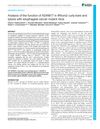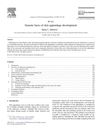Mice humanised for the EGF receptor display hypomorphic phenotypes in skin, bone and heart
August 2003
in “
Development
”
TLDR Mice with human-like EGFR had growth issues, skin defects, heart problems, and unusual bone development.
Mice humanised for the epidermal growth factor receptor (EGFR) displayed hypomorphic phenotypes, including growth retardation and skin and hair defects similar to Egfr-/- mutants, but with rescued neurodegeneration. These hEGFRKI/KI mice, viable up to six months, developed severe heart hypertrophy and semilunar valve abnormalities. They also showed accelerated chondrocyte and osteoblast differentiation, a novel phenotype not previously described. The severity of these phenotypes was linked to the expression levels of the hEGFRKI allele, which was inefficiently expressed in epithelial and bone cells but expressed at higher levels in the brain and heart, indicating tissue-specific effects and a new role for EGFR in bone development.



